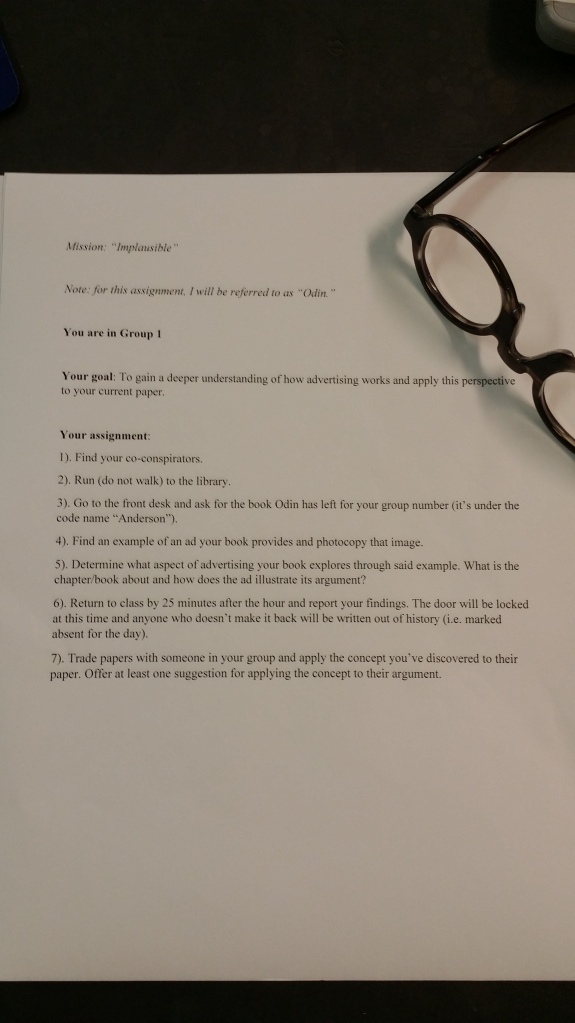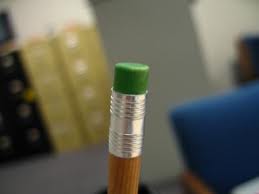
I am about to step into the Undiscovered Country.
For whatever reason, since I’ve become a “professional,” I’ve continually sought out the “amateur.” In a later post, I plan on exploring this ethic more deeply, but for now, all I mean is that my so-called success in landing a job as an English professor has emboldened me to ruthlessly experiment with my teaching methods. Maybe I’m too cocky for my own good, but finishing my terminal degree seems to have relieved a self-imposed pressure to please my betters and explore the possibilities of teaching English in ways that speak to my own passions and imagination.
Generally, my teaching style is to institute a bit of anarchy in the classroom. I have an agenda, but whatever I put on it depends on my students participating and pursuing their own education, not passively sitting back as I provide information.
Consumers do not enjoy my classes.
But I stress to my students that the activity I require, though sometimes chaotic, is meant to keep them from settling into a passivity that can stifle education. I do understand that different people have different learning styles, and that some people are engaged as they passively sit back, watch, and listen. Believe it or not, I myself am one of those people. I account for this as best I can by providing some instruction each class, but it is usually supplemented by exploratory writing, group workshops, and some sort of problem-solving activity. My role in the class is, in a sense, like that of Groucho Marx in the great movie Horse Feathers.
Groucho, playing Quincy Adams Wagstaff, institutes chaos among a stuffy college faculty, then organizes the anarchy into a highly crafted production. This is my goal each class, my garden of pedagogical Eden.
I am aware of my motives, but self-awareness comes with a price. I’ve slowly come to realize that each time I teach, I have one specific student in mind.
Me.
My first run at college ended in failure as I was unable to conjure a vision of myself that was sufficient enough to keep me interested in learning. The professorial me is now always and forever trying to reach the withdrawn, aimless, youthful me that follows me into every classroom. His ghost still haunts the man he has become.
I think that my students largely enjoy my classes, but they must be ever so confused at the figure at the front of their classroom. I think the picture above captures my fragmented ego better than my words can describe it. I am, in many ways, both men in that publicity shot. Culture and Anarchy, bitter enemies and passionate lovers, working together. This is the chaotic contradiction I draw on to try and empower my students. This chimera. This boy-man. This momentary professor who is an eternal student.
Well, given this back-story and my propensity for experimentation, I was knocked over by a comment I received this week on this blog. In my post “Dear Student: Teaching as Relationship,” I wrote about a certain assignment prompt I wrote as a personal letter to my students. I received the following comment:
Have you also done this assignment? I teach a boatload of composition courses and find that doing my own assignments gives me perspective. I just take it through the rough draft. That’s not critique or advice, by the way. I just want to know.
This, quite frankly, blew my mind, and I am ever so grateful for this person taking the time to comment. The idea of doing one of my own assignments has never crossed my mind, but I found the idea irresistible. Not to psychoanalyze myself, but the notion of attempting as a student an assignment I designed as a teacher beautifully captures the exhilarating terror of the split personality I bring into my classroom. Immediately I began plotting.
So here is the experiment. My research writing class is about to undertake their semester-long research assignments. I, as a good faculty member, conduct my own research all the time anyway, so why not do a research paper with my students? It began today. I had planned a set of activities to help my classes work from their questions about their topic to working thesis statements that will send them off hunting for their first volley of research. So I explained my plan and, like an engaged student would do, presented my own research project using the same four steps I had asked them to use. I then committed to preparing my own annotated bibliography, my own research proposal, my own rough draft…everything I am requiring them to do I am going to do myself.
With them. As one of them.
I admitted to my students that this was an enthusiastic experiment and it may end up as a foolish idealistic failure, but even so, I wanted them to feel a sense of ownership in this class. My attempt at leveling the distance between student and teacher was meant to treat them as intellectual peers as well as my students. How this balance will work, we will all learn together. I asked how they felt about this experiment and most of them expressed an enthusiasm for it.
Then something astonishing happened.
I set them off developing their own working thesis statements and, stepping back into my teacher-self, scurried among them, answering any questions they had about their projects. The number of thoughtful, probing questions I fielded was dizzying. Everyone had real questions about how to pursue topics that suddenly seemed to matter very much to them. My students were engaged, and I was elated.
This pedagogical bliss then reached a magnificent crescendo, a chaos worthy of Groucho Marx himself. One of my students took my playful experimentation and threw it right back at me. “Do we get to grade your paper at the end?” he asked.
This is going to be so much fun.
I will try and provide periodic updates about this adventure. In the meantime, I would love to hear from you about your experiences or concerns with my teaching methods and would gladly receive any advice. Please feel free to comment either here or, even better, at The Arnoldian Project Facebook page (like the Project at the upper left corner).











